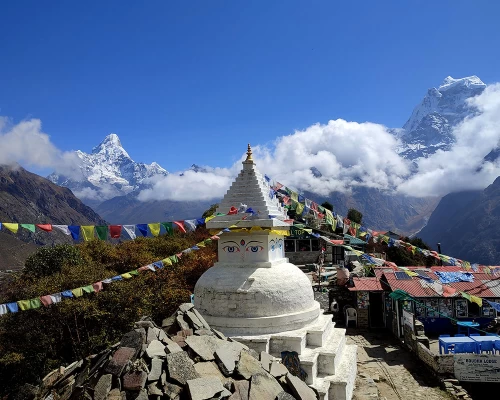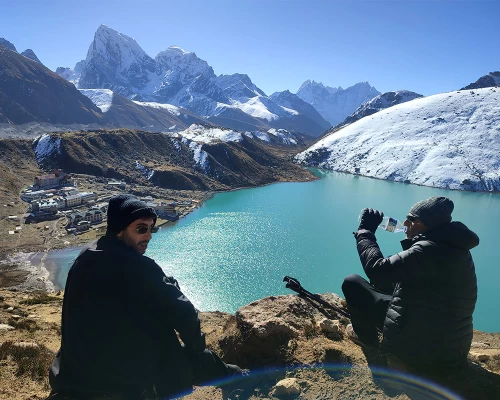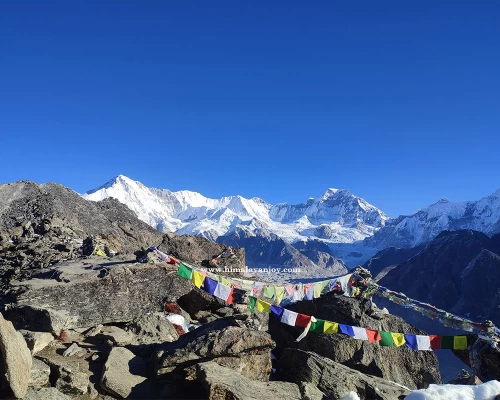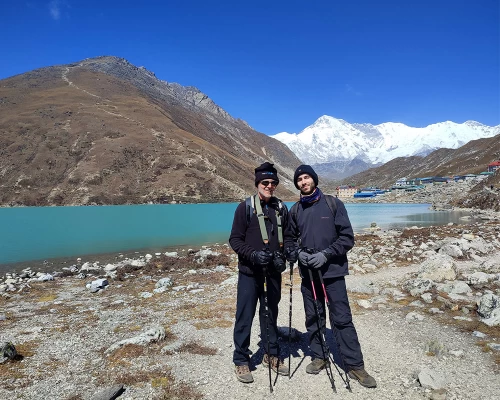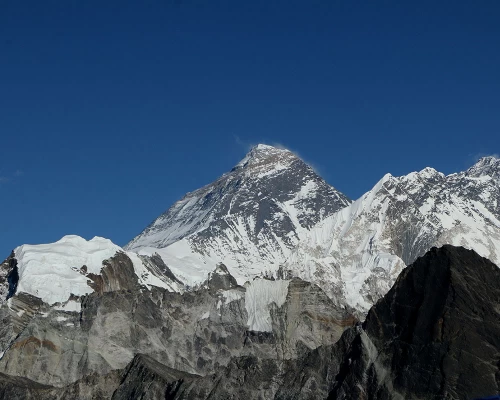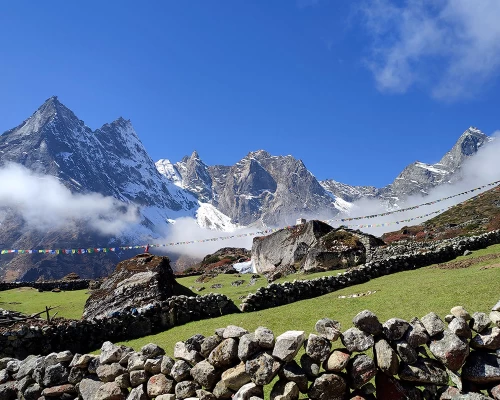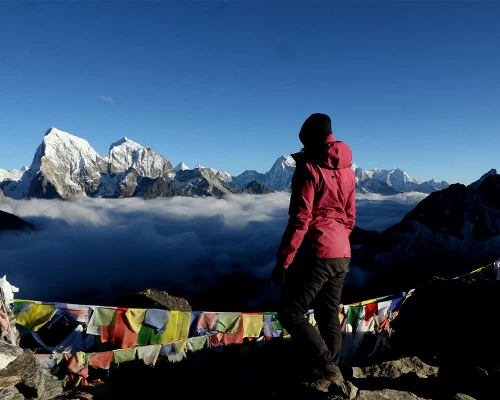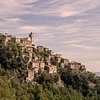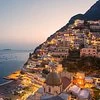Trek highlights - Gokyo Valley Trek
- The trek includes the Ngozumpa Glacier, Nepal’s largest glacier, and the beautiful Gokyo Lakes, a group of clear blue lakes located between 4,700 and 5,000 meters, showing the amazing beauty of the Himalayas.
- Climbing Gokyo Ri, which is 5,357 meters high, gives you an incredible view of the Everest region, including four of the world’s tallest mountains, Everest, Lhotse, Makalu, and Cho Oyu, with sunrise and sunset turning the snowy peaks golden and pink.
- The Gokyo Lakes are six sacred blue lakes formed by glaciers, sitting high in the mountains, offering peace and stunning views, especially from the nearby Gokyo Ri summit.
- The Ngozumpa Glacier, the longest glacier in the Himalayas at over 36 kilometres, is a huge area of ice, cracks, and rocky debris, giving trekkers a chance to see the impressive power of glaciers.
- The Sherpa culture, deeply connected to Buddhism, is shown through old monasteries, local festivals, and the kind and welcoming Sherpa people, giving you a special cultural experience.
- Trekking in the heart of the Himalayas takes you through different landscapes, from green valleys and forests to rocky paths and dry high-altitude areas, making it an exciting and memorable journey.
- The trail passes through traditional Sherpa villages with stone houses and fields, surrounded by tall mountains, and ancient Buddhist monasteries with prayer flags and art, offering a calm and spiritual atmosphere.
Gokyo Valley Trek Overview
Gokyo Valley Trek is one of the most popular trekking routes in the Everest region. This trek takes you to Gokyo Ri, a stunning viewpoint, and the beautiful Gokyo Lakes, a group of breathtaking Himalayan glacial lakes. With towering peaks over 8,000 meters and pristine alpine lakes, this route is considered one of the most scenic trails in the Himalayas.
The trail winds through the magical Gokyo Valley, surrounded by untouched natural beauty and towering peaks. The scenery is breathtaking, offering panoramic views of world-famous mountains like Mt. Everest (8,848 m), Mt. Makalu (8,463 m), Mt. Lhotse (8,516 m), and Mt. Cho Oyu (8,201 m). The combination of snow-covered summits, deep valleys, and shimmering lakes creates an unforgettable trekking experience.
At Himalayan Joy Adventure, we offer a 13 day Gokyo Valley Trek, starting and ending in Kathmandu. The journey begins with a flight to Lukla, followed by a steady walk from Phakding to Namche Bazaar, the vibrant center of the Khumbu region. To help trekkers adjust to the altitude, we include a rest day in Namche, featuring a short hike to Everest View Hotel, which offers stunning views of Everest and surrounding peaks.
As the trek continues through Dole and Machhermo, the altitude gradually increases, leading to the picturesque Gokyo Valley, home to the famous Gokyo Lakes. One of the biggest highlights of the trek is the hike to Gokyo Ri (5,357 m), which rewards trekkers with some of the most spectacular views in the Himalayas. The return journey follows the same route through Dole and Namche, allowing for a gradual descent before flying back to Kathmandu.
With a well-planned itinerary, proper acclimatisation days, and fewer crowds than the Everest Base Camp trek, the Gokyo Valley Trek is a perfect choice for those seeking both adventure and serenity in the Himalayas.
Bookings for 2025 are now open! If you’re interested, you can check the availability and pricing of the 13 days Gokyo Valley Trek in the section below. If you would like to customize the itinerary or adjust the trekking duration, we also offer tailored services. Feel free to contact us for more details!
Where is the Gokyo Valley Trek Located?
The Gokyo Valley Trek is in the Everest region of Nepal, a place that feels like it’s from another world. Imagine towering snowy mountains, bright blue lakes and small Sherpa villages, that’s the beauty of Gokyo Valley, a truly majestic place.
To reach it, you first take a short flight from Kathmandu to Lukla, a small town known as the starting point for treks in the Himalayas. From there, you walk through green forests, cross wobbly bridges over rushing rivers, and pass through villages like Namche Bazaar, a lively spot in the mountains. As you go higher, the air gets thinner, the views get more amazing, and the adventure feels even more exciting.
Gokyo Valley sits high up, between 4,700 and 5,000 meters, surrounded by some of the tallest mountains in the world, like Everest, Lhotse, Makalu, and Cho Oyu. It’s a peaceful, untouched place where nature feels wild and powerful. The valley is famous for the Gokyo Lakes, a group of stunning blue lakes that reflect the mountains, and Gokyo Ri, a peak with one of the most incredible views you’ll ever see.
How does the Gokyo Valley Trek differ from the classic Everest Base Camp Trek?
The Gokyo Valley Trek and the Everest Base Camp Trek are both amazing trekking routes in the Himalayas, but they offer different experiences. Think of them as two exciting stories—one takes you deep into the peaceful heart of the mountains, while the other follows the famous path of past climbers.
The Everest Base Camp Trek is the most well-known. It is the one many people dream of because it takes you right to the base of Mount Everest. Along the way, you will pass through lively villages like Namche Bazaar, cross high suspension bridges, and visit the famous Tengboche monastery. The trail is busy with trekkers from all over the world, making it feel like a grand journey filled with history and excitement.
On the other hand, the Gokyo Valley Trek is quieter and more scenic. Instead of heading to Everest Base Camp, this trek takes you to the breathtaking Gokyo Lakes, beautiful blue glacial lakes surrounded by towering peaks. You will also climb Gokyo Ri, a viewpoint that offers one of the best panoramic views in the Everest region. From the top, you can see Everest, Lhotse, Makalu, and Cho Oyu, with the lakes shining below. Since fewer people take this route, you will often feel like you have the mountains all to yourself.
The landscapes are also different. The Everest Base Camp Trek goes through the Khumbu Valley, passing through busy villages and well-known stops. However, the Gokyo Valley Trek takes you past the massive Ngozumpa Glacier, the largest glacier in the Himalayas. Walking beside this endless stretch of ice feels like stepping into another world.
Both treks are challenging, but the Gokyo Valley Trek is slightly harder because of the higher altitude and the climb to Gokyo Ri. However, the reward is a sense of peace and natural beauty that’s hard to beat. While the Everest Base Camp Trek is about adventure and history, the Gokyo Valley Trek is about solitude and stunning scenery.
Choosing between the two depends on what kind of experience you want. If you dream of standing at the foot of Everest, go for the Everest Base Camp Trek. But if you prefer quieter trails, shimmering lakes, and incredible views, the Gokyo Valley Trek might be the perfect choice. Either way, both treks promise an unforgettable adventure.
How difficult is the Gokyo Valley Trek?
The Gokyo Valley Trek is a moderate-level trek in the Everest region, meaning it’s challenging but manageable for most trekkers. You will be walking 5–6 hours a day on mountain trails, so being physically prepared is important. If you can comfortably walk this long, you should be able to complete the trek. To make the journey easier, it is recommended to do some basic physical training before starting.
One of the biggest challenges is the cold weather. The Gokyo Valley has a tundra climate, meaning temperatures stay low all year round, even in warmer months. The cold can be tough, so packing the right clothes is essential to stay warm and comfortable.
The trek is mostly peaceful and scenic, but some parts, such as high passes and rough trails, can be difficult for beginners. To make the trek safer and easier, we strongly recommend hiring a licensed guide. The good news is that our 13 days Gokyo Valley Trek itinerary at Himalayan Joy Adventure includes an experienced guide, a porter, and all necessary permits to ensure a smooth and enjoyable journey.
Gokyo Valley Trek Cost in 2025
The cost of the Gokyo Valley trek is between USD $1600 and USD $1800. The price can change based on factors like group size. Solo travellers often pay more, while people trekking in a group can save money. In a group, the cost for the porter and guide is shared, and transportation becomes cheaper.
At Himalayan Joy Adventure, we offer a 13-day Gokyo Valley Trek for USD 1650 per person. This price includes most of the essentials, like a guide, lodging, and permits. We also offer discounts for larger groups. The bigger the group, the lower the price. You can check the price table below.
| No of Pax | Starting price (Per Person) |
|---|---|
| 1-2 pax | USD 1650 |
| 3-5 pax | USD 1600 |
| 6-10 pax | USD 1550 |
| 11-15 pax | USD 1500 |
| 16-20 pax | USD 1450 |
If you have any questions regarding the 13 days Gokyo Valley Trek's price or itinerary, please feel free to contact us via WhatsApp.



